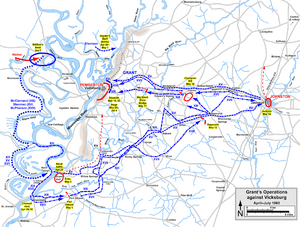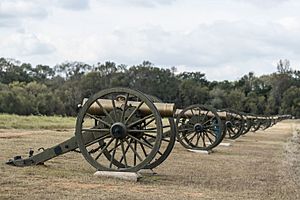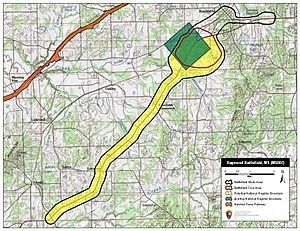Battle of Raymond facts for kids
Quick facts for kids Battle of Raymond |
|||||||
|---|---|---|---|---|---|---|---|
| Part of the American Civil War | |||||||
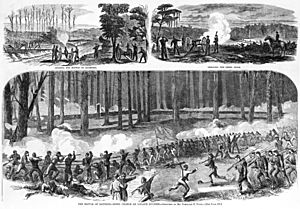 Three sketches of the battle by Theodore R. Davis |
|||||||
|
|||||||
| Belligerents | |||||||
| Commanders and leaders | |||||||
| James B. McPherson | John Gregg | ||||||
| Units involved | |||||||
| XVII Corps | Gregg's brigade | ||||||
| Strength | |||||||
| 10,000 to 12,000 | 3,000 to 4,000 | ||||||
| Casualties and losses | |||||||
| 442 or 446 | 514 or 515 | ||||||
The Battle of Raymond happened on May 12, 1863, near Raymond, Mississippi. It was part of the Vicksburg campaign during the American Civil War. The Union army wanted to capture Vicksburg, a very important city on the Mississippi River.
Earlier attempts by the Union to take Vicksburg had failed. In April 1863, Union Major General Ulysses S. Grant tried again. His army crossed the river into Mississippi. After winning the Battle of Port Gibson, Grant moved his troops east. He planned to then turn west and attack Vicksburg.
Part of Grant's army, led by Major General James B. McPherson, moved northeast. This group, called the XVII Corps, had about 10,000 to 12,000 soldiers. The Confederate commander in Vicksburg, Lieutenant General John C. Pemberton, sent Brigadier General John Gregg and his 3,000 to 4,000 soldiers from Jackson to Raymond.
On May 12, Gregg's soldiers met McPherson's leading troops. Neither general knew how strong the other side was. Gregg attacked first, thinking McPherson's force was small. McPherson thought the Confederates were stronger than they were, so he was careful.
At first, the battle was fairly even. Two Union brigades fought Gregg's men. But then, McPherson brought in more Union soldiers. The larger Union numbers started to break the Confederate line. Gregg decided to pull his troops back. McPherson's men did not chase them right away.
The Battle of Raymond changed Grant's plans. He decided to attack the Confederate forces in Jackson first. After capturing Jackson, Grant's army turned west. They pushed Pemberton's army into Vicksburg. The Confederates surrendered on July 4, ending the Siege of Vicksburg.
Contents
Why Vicksburg Was Important
Controlling the Mississippi River
Early in the American Civil War, the Union had a plan called the Anaconda Plan. A big part of this plan was to control the entire Mississippi River. By early 1862, the Union controlled much of the river valley. They had captured cities like New Orleans, Louisiana.
But the city of Vicksburg, Mississippi was still held by the Confederates. Vicksburg was very important because it was on high ground overlooking the river. It was also a key link between the two halves of the Confederacy. Union ships tried to take Vicksburg in May 1862 but failed. Later, a joint army and navy attack also failed. They even tried to dig a canal to bypass the city, but that didn't work either.
Grant's Early Attempts
In late November 1862, Union Major General Ulysses S. Grant led about 40,000 soldiers south from Tennessee towards Vicksburg. But his supply lines were attacked and destroyed. Grant had to order a retreat.
At the same time, another Union group, led by Major General William T. Sherman, traveled down the Mississippi River. Sherman's men attacked Confederate defenses near Chickasaw Bayou. On December 29, the Union attack was badly defeated. Sherman's troops pulled back in January 1863.
Getting Ready for Battle
Grant's New Plan
In early 1863, Grant made new plans to capture Vicksburg. He tried different ways to bypass the city, like digging canals or going through bayous (swampy waterways). But none of these routes worked.
By March 1863, Grant had three choices. He could attack Vicksburg head-on across the river, which would be very risky. He could go back to Memphis and attack from the north. Or he could march south on the Louisiana side of the river and cross it below Vicksburg. Grant chose the southward march. He thought going back to Memphis would look like a defeat.
On April 29, Union ships attacked Confederate forts at Grand Gulf, Mississippi. The next day, Grant crossed his army even further south, at Bruinsburg, Mississippi.
Grant's Army Moves Inland
Grant moved inland with 24,000 soldiers. On May 1, they defeated a Confederate force of 8,000 men at Port Gibson, Mississippi. The Confederates then left their forts at Grand Gulf.
Grant could either go north towards Vicksburg or head east and then turn west. He chose to go east first. This gave him a better chance to trap the Confederate army in Vicksburg. Grant sent Sherman's XV Corps to cross the Mississippi River at Grand Gulf. They then marched towards Auburn.
To Sherman's left, Major General John A. McClernand's XIII Corps covered the crossing of the Big Black River. On the Union right, Major General James B. McPherson's XVII Corps moved towards Raymond. McPherson's advance met little resistance, mostly from local soldiers.
Gregg's March to Raymond
The Confederate commander, Lieutenant General John C. Pemberton, moved his troops north. He was watching the Union army. Meanwhile, more Confederate soldiers arrived in Jackson. General Joseph E. Johnston was sent to command these growing forces, which reached about 6,000 men.
One of these units was Brigadier General John Gregg's brigade. Pemberton ordered Gregg to take his brigade to Raymond. He hoped Gregg could stop a Union unit rumored to be near Utica. Both Gregg and Pemberton thought this Union force was only about 1,500 men. But it was actually McPherson's corps, with 10,000 to 12,000 soldiers.
Pemberton believed the main Union attack would be at the Big Black River. He thought any movement towards Jackson via Raymond was just a trick. He told Gregg to retreat to Jackson if the Union pushed through Raymond. But if the Union army turned towards the Big Black River, Gregg was to attack their rear.
Gregg and his men arrived in Raymond on May 11. They expected to find Confederate cavalry there, but only a small group of 40 local cavalrymen were present. Gregg sent scouts out. On the morning of May 12, the scouts reported Union soldiers approaching. Gregg, still thinking he faced only a small force, prepared for battle with his 3,000 to 4,000 men. He decided to attack aggressively.
Gregg set up his troops to draw the Union soldiers into a trap. He placed some units to attack the Union front. Other units were sent to try a flanking attack (attacking from the side) on the Union right. His cannons were placed to fire on Union soldiers crossing a bridge. He kept one regiment in reserve. His battle line was spread out and had gaps. Thick bushes made it hard for Gregg to see how many Union soldiers were coming.
The Battle Begins
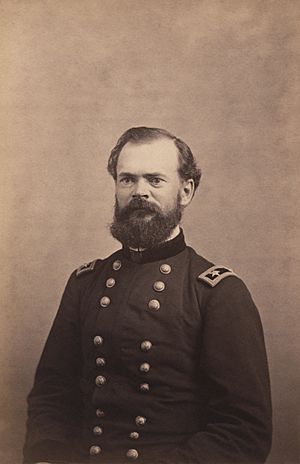
First Shots Fired
The fighting started on the morning of May 12. Union cavalry, the first troops, ran into Confederate skirmishers (soldiers sent ahead to scout and fight lightly). The Union soldiers were surprised.
Gregg was told the Union force was only about 2,500 to 3,000 men. This made him even more sure he was facing a small group. Confederate cannons began firing. Union cannons also fired back. Smoke from the firing made it hard to see.
Around 9:00 AM, McPherson realized he was facing more than just a few skirmishers. He started to get his army ready for a full battle. He used cavalry to protect his sides (flanks). He brought up Brigadier General Elias Dennis's brigade of four regiments to the front. Union cannons were brought up, giving them a big advantage in firepower.
Union Brigadier General John E. Smith's brigade of Logan's division arrived and attacked the Confederate line. Only one of Smith's regiments managed to cross the creek. The others got stuck in the thick bushes.
Confederate Attack and Union Response
With Union troops focused on one road, Gregg decided to bring his troops closer together and attack. His plan was for two of his regiments to attack in a staggered line. Two other regiments were to move off the road and hit the Union line from the side. Gregg hoped these flanking units could capture McPherson's cannons.
Gregg's Texans hit two Union regiments hard. One Union regiment held its ground, but the other broke and ran back. The Union line started to bend. But Major General John A. Logan, the division commander, rallied his troops. McPherson, being less experienced, thought the Confederate force was much larger than it was.
The 3rd Tennessee Confederate regiment attacked the Union soldiers, pushing them back across the creek. The attacking Tennesseans then moved southeast. Gregg brought up his reserve regiment, the 41st Tennessee. But he still didn't know the true strength of the Union army. Heavy smoke and dust made it hard for Gregg to control the battle.
Growing Confusion
A third Union brigade, led by Brigadier General John D. Stevenson, had been held back. As the battle got more intense, Stevenson moved his men forward. McPherson ordered Stevenson to support the other Union brigades after the Confederate attack.
Stevenson's four regiments were split up. Some went to support the main fight. Others moved to strengthen the Union right side. This meant Gregg's flanking regiments would not hit an unprotected Union position. When some of the 50th Tennessee Confederates fired too early, they lost the element of surprise. Their commander tried to tell Gregg the Union force was much bigger, but the messenger couldn't find him.
The 50th Tennessee fell back without telling other Confederate units. The other flanking unit waited for the 50th Tennessee to attack first. So, Gregg's flanking attack stopped.
On the other side of the Confederate line, a Union attack pushed back the 7th Texas. The battle lines changed. The 3rd Tennessee continued to advance, expecting its left side to be covered by the 50th Tennessee. But the 50th Tennessee wasn't there. This left the 3rd Tennessee's side open to Union fire.
Union troops attacked the 3rd Tennessee with four regiments. They drove them back after a 45-minute fight. More Union cannons arrived, giving them an even bigger advantage.
The battle became very confusing because of the thick bushes and smoke. Units on both sides fought more on their own. Around 1:30 PM, a new Union brigade arrived. Two of its regiments were sent to help the main Union line. The 7th Texas was pulling back.
The 50th Tennessee and another Confederate regiment prepared to attack together. But they waited for orders that never came. The 50th Tennessee heard heavy fighting to their right and started taking fire. They fell back to where they started. The other regiment moved towards the center of the line. This left a gap in the Confederate line.
Union Breaks Through
McPherson brought 22 cannons onto the field. Some of his men forced their way across the creek and met the 50th Tennessee. The Union cannons began firing on the exposed 10th and 30th Tennessee (Consolidated) regiment.
Knowing that retreating would break the Confederate line, their commander, Colonel Randal William McGavock, ordered an attack. He was killed early in the charge. But his men pushed back a Union regiment before being stopped. A Union counterattack drove them back.
The large number of Union soldiers was starting to win the battle. Gregg decided a retreat was needed. He ordered one of his regiments to pretend to attack, to cover the retreat of his tired soldiers. The Union troops fell for the trick and pulled back, allowing the Confederates to retreat.
The 10th and 30th Tennessee (Consolidated) also began to retreat. They attacked a Union regiment from Ohio, but were driven back by stronger Union forces. Other Confederate units also pulled back. Six companies of Kentucky cavalry arrived unexpectedly and helped cover the retreat.
Gregg's men retreated through Raymond and onto the road to Jackson. They stopped for the night in some woods. Fighting ended around 4:00 PM. Union soldiers entered Raymond. They found and ate a meal that local women had prepared for Gregg's men, expecting a Confederate victory. Gregg's men left their wounded behind and fell back to Jackson the next day. McPherson did not chase them because the land was difficult.
What Happened Next
The number of Union soldiers killed, wounded, or missing was around 442 to 446. Confederate losses were reported as about 514 or 515. The Confederates lost one of their cannons during the fight. Union wounded were treated in churches. A Confederate hospital was set up in the courthouse.
The Battle of Raymond showed Grant that the Confederate forces in Jackson were stronger than he thought. He decided he had to defeat them first. This would prevent them from attacking his army from behind while he attacked Vicksburg. Grant brought his whole army to attack Jackson.
On May 14, the Union army attacked Jackson. General Johnston pulled his men out of the city. Gregg's brigade helped protect the retreat. Grant's army then turned west. They met Pemberton's men, who were trying to defend Vicksburg.
On May 16, Pemberton's men were defeated at the Battle of Champion Hill. After another defeat the next day, they retreated into Vicksburg's defenses. Union attempts to take the city by direct attack on May 19 and 22 failed. Grant then started a siege of Vicksburg.
Supplies in Vicksburg ran low. Pemberton surrendered the city and his army to Grant on July 4. The capture of Vicksburg was a very important moment in the war.
Looking Back at the Battle
Historians have different opinions on how the generals handled the Battle of Raymond. Some historians say McPherson was too careful or even timid. They point out that he didn't use his troops or his many cannons very well. They also say he made a mistake by not chasing the Confederates after the battle.
Other historians believe McPherson didn't have a clear plan. They say he just sent troops into the fight without much overall direction. They think the Union won mostly because they had more soldiers, not because of McPherson's leadership.
Some historians criticize Gregg for being too aggressive. They say he didn't figure out how strong the Union army was. But others believe Gregg showed real skill in planning and inspiring his soldiers. They think the Confederates lost because Gregg didn't know the true size of the Union force.
Protecting the Battlefield
The site of the Battle of Raymond was added to the National Register of Historic Places in 1972. In 1971, it was noted that parts of the battlefield had changed. Some areas were used for farming, homes, or businesses. Two roads cut through the field. The place where a Confederate cannon battery was located is now covered by a building.
In 1993, a study ranked the Raymond battlefield as a top priority for protection. A reenactment of the battle happened there in 2001. In 2010, another study found that about 79 percent of the battlefield was still in good condition. This included the Union cannon position and the creek.
The Friends of Raymond group manages about 135 acres of the site. They call it the Raymond Military Park. They have walking trails and signs to help people learn about the battle. In 2020, a grant was given to buy more land at Raymond. This land connects parts of the battlefield that are already protected.


